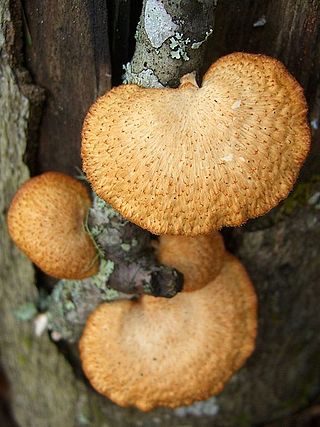Top Qs
Timeline
Chat
Perspective
Neofavolus alveolaris
Species of fungus From Wikipedia, the free encyclopedia
Remove ads
Neofavolus alveolaris, commonly known as the hexagonal-pored polypore,[3] is a species of fungus in the family Polyporaceae. It causes a white rot of dead hardwoods. Found on sticks and decaying logs, its distinguishing features are its yellowish to orange scaly cap, and the hexagonal or diamond-shaped pores. It is found in Eurasia and Australia; once thought to be widely distributed in North America, these specimens may belong to Neofavolus americanus.
Remove ads
Taxonomy
The first scientific description of the fungus was published in 1815 by Augustin Pyramus de Candolle, under the name Merulius alveolaris.[4] In 1821, it was sanctioned by Elias Magnus Fries as Cantharellus alveolaris. It was transferred to the genus Polyporus in a 1941 publication by Appollinaris Semenovich Bondartsev and Rolf Singer.[2] It was transferred to its current genus in 2012.
The genus name is derived from the Greek meaning "many pores", while the specific epithet alveolaris means "with small pits or hollows".[5]
Remove ads
Description
Summarize
Perspective
The kidney-shaped caps are cream with reddish scales, measuring 1.5–6 cm (1⁄2–2+1⁄2 in) across and 5–10 millimetres (1⁄4–1⁄2 in) thick near the base; the light flesh hardens with age.[6] The whit [[]] ish stipe widens into the cap, measuring 0.5–1 cm long and 3–7 mm thick.[6] The pores are whitish, maturing to yellow, and cover the stipe (decurrent); they are 0.5–3 mm across and rectangular to hexagonal, being rounder near the margin.[6] The spore print is white.[6]
Microscopic features
The spores are narrowly elliptical and smooth, hyaline, with dimensions of 11–14.5 × 4–5 μm. The basidia are club-shaped and four-spored, with dimensions of 28–42 × 7–9 μm.[7]
Similar species
North American specimens may be Neofavolus americanus, with DNA sequencing possibly the only method of distinction.[6]
Polyporus craterellus bears a resemblance to P. alveolaris, but the former species has a more prominent stalk and does not have the reddish-orange colors observed in the latter.[8] Polyporus mcmurphyi and related species have larger caps and a more defined stem.[6] Favolus brasiliensis lacks orange tones and Cerioporus squamosus is larger.[6]

Remove ads
Habitat and distribution
Neofavolus alveolaris is found growing singly or grouped together on branches and twigs of hardwoods, commonly on shagbark hickory in the spring and early summer.[9] It has been reported growing on the dead hardwoods of genera Acer, Castanea, Cornus, Corylus, Crataegus, Erica, Fagus, Fraxinus, Juglans, Magnolia, Morus, Populus, Pyrus, Robinia, Quercus, Syringa, Tilia, and Ulmus.[10]
This species has been collected in Europe (Czechoslovakia,[11] Italy,[12] and Portugal),[13] China,[14] and Australia.[15] It was once thought to be widely distributed in eastern North America, but these specimens may belong to N. americanus.[5][9][6]
Uses
This mushroom is edible when young.[16] It has been described as "edible but tough",[17] with toughness increasing with age, and not having "all that distinctive of a flavor".[18] Another reference lists the species as inedible.[19]
A polypeptide with antifungal properties has been isolated from the fresh fruit bodies of this species. Named alveolarin, it inhibits the growth of the species Botrytis cinerea, Fusarium oxysporum, Mycosphaerella arachidicola, and Physalospora piricola.[20]
Remove ads
References
Wikiwand - on
Seamless Wikipedia browsing. On steroids.
Remove ads


